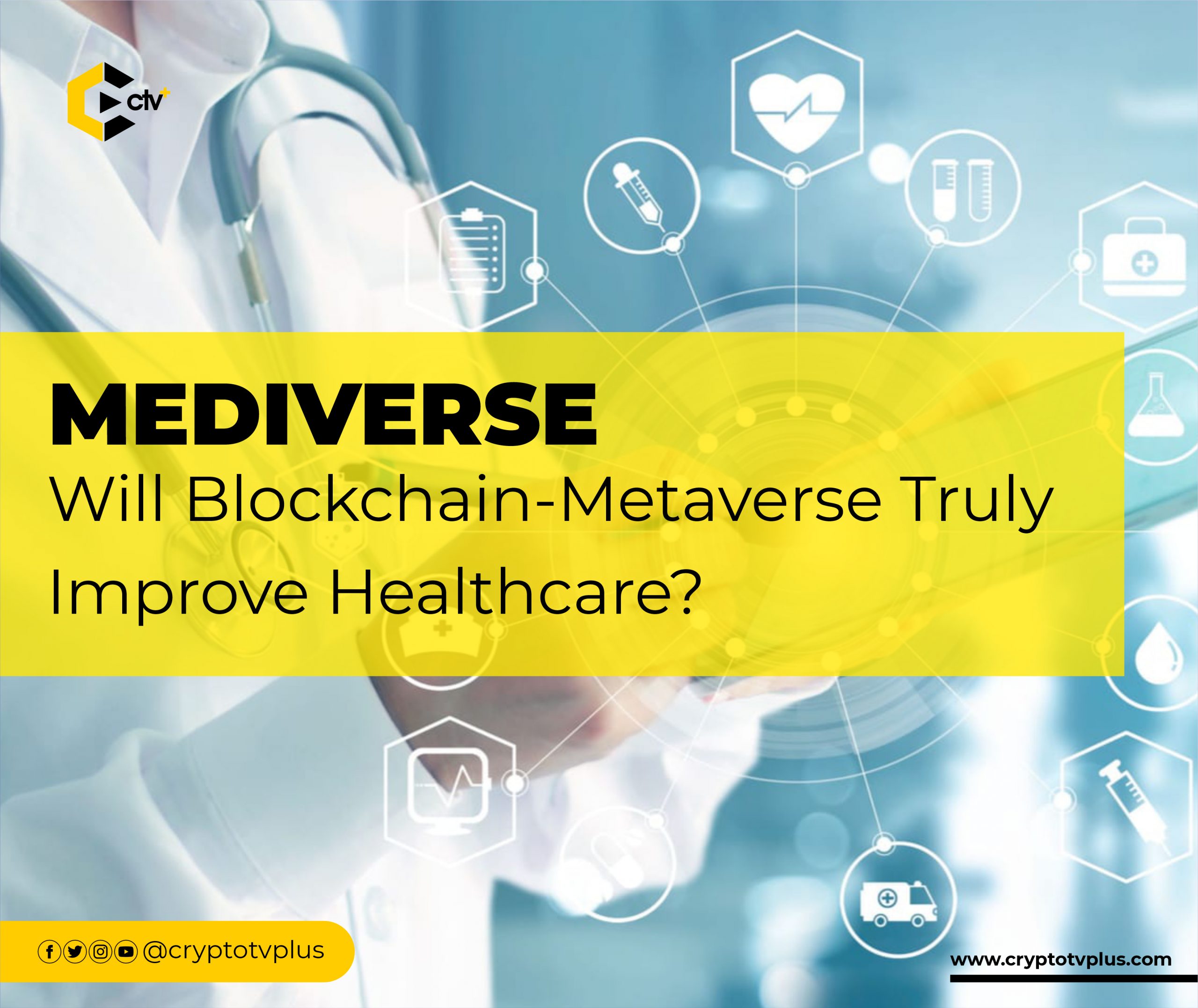FEATURED
‘Mediverse’: Will Blockchain-Metaverse Truly Improve Healthcare?

No one can fully talk about the Metaverse today without mentioning the origin of the word, the event that made the concept so greatly important, and the blockchain attributes in it.
The interplay between medicine and the virtual world began a long time ago. It started when man decided to improve on medical practices through innovative ideas.
What is the Metaverse?
The Metaverse is an ideology backed by technology or an environment we are creating for ourselves beyond the physical one we experience daily. Why an ideology? We believe it is real but we cannot touch it, yet it has profound effects on us.
For the sake of a formal definition, metaverse is “‘a combination of multiple elements of technology, including virtual reality, augmented reality where users “live” within a digital universe,”‘ according to USA Today.
Medicine and Technology
Technology is at the heart of the Metaverse. The Britannica says that technology is “the application of scientific knowledge to the practical aims of human life or, as it is sometimes phrased, to the change and manipulation of the human environment”.
It is also “a manner of accomplishing a task, especially using technical processes, methods, or knowledge,” says Merriam-Webster Dictionary. If these definitions are true, then technology and medicine have been rubbing minds together for a long while.
There are several innovations created for medical advancements that were refused and medicine that have been produced but were not accepted initially. Antiseptic Handwashing by Ignaz Semmelweis, Newborn Incubators by Stéphane Étienne Tarnier, the Cancer Immunotherapy of James Allison, and then the Traumatic Brain Injuries in Sports uncovered by one of Nigeria’s finest pathologists, Dr. Bennet Omalu.
The same world that said no we don’t need this and that, has spent so much money and time making sure that these products become accessible to people. Thanks to the union of medicine and technology.
Read this also:
- How Relics from Monstercat is Changing the World of Music NFTs
- Will the Metaverse Make People Lose Touch With Reality?
- Top Global Corporations in the SandBox Metaverse
Today’s Metaverse
Virtual reality can be traced to simulators in 1939. That industry has grown so large being valued at $30.7b in 2021 and projected at $300b by 2024. A perfect use case or product sample of Virtual Reality or Augmented Reality or Mixed Reality is Oculus equipment created to be used in virtual environments.
Today’s metaverse is not just a space with little or no utilities. For gamers, it is a 3D world that’s immersive so that two or more persons, with a distance of more than 4000 miles apart, can participate in a gaming competition. And it feels so real as though they were together.
As if this is not enough, the development of the metaverse is opening a new frontier. This can be traced to when Bitcoin was officially launched in 2009. Then, Vitalik opened a new chapter on blockchain technology – the introduction of autonomous agents also known as smart contracts today; DeFi to GameFi and Metaverse.
And so, we have;
Blockchain-powered Metaverses
First, blockchain is the technology that drives cryptocurrencies. For each project, there’s a unique blockchain on which it runs. Blockchain can be seen as a system of computing and storing data in a safer and decentralized manner.
So, blockchain-powered platforms are supported by blockchain technology which brings all the features, advantages, and downsides of blockchain to the metaverse. Currently, two of the greatest features combined in this fusion are entertainment and economics. Another name for this is GameFi.
Yes, there’s a project called GameFi but the original idea for that word is Gaming and Decentralization with a focus on money and access to the platform. So DeFi (Decentralized Finance) merges with Gaming to produce GameFi. Users of these platforms can play-to-earn (Wrestling Metaverse), move-to-earn (StepN), build-to-earn (MetaStrike), train-to-earn (Earn Guild), farm-to-earn (Happyland) etc.
What else can be done in the metaverse?
Applications of the Metaverse
Marketing is one major application of the Metaverse.
Trying and failing to get into a Samsung event in the metaverse pic.twitter.com/u9NMtLpLjR
— Sam Shead is o.o.o 🌴 (@Sam_L_Shead) February 9, 2022
That’s someone trying to use the Samsung virtual space in Decentraland, one of the top metaverse projects. Gucci, JP Morgan, and HSBC are also in the metaverse. In 2015, it’ll interest you to know that the Presidential Debate was streamed in a virtual world, laying the ground for a metaversical approach to political discourse.
Three other major use cases of Extended Reality or what we describe as Metaserve (AR or CR or MR) are for education, manufacturing, and healthcare. For education, SkyView (for exploration of the universe), Froggipedia (explore the internal structures of a frog), Google Expedition (for a virtual tour of places around the world), Virtual Space (training people in public speaking) etc are some of the best platforms using VR for training.
Then for manufacturing, FIVE by Ford is changing how cars are designed and produced; Skylight Industrial Augmented Reality is used by GE in the aerospace division to optimize their production process. The next application is the;
The Mediverse: medicine and the Metaverse
If VR is important in manufacturing, banking, education, and farming, health will not be left out. Medivis is a “native-health” VR innovation created by surgeons, radiologists, and engineers. The focus is on surgical activities.
Medivis is just one out of so many applications of VR in medicine. Chris Morley, a Radiologist with Medivis reiterated about VR in medicine that “Holographically overlaying patient data at the point of care can reduce procedure times, complication rates and radiation exposure.”
The opinion of Chris above is fair enough to show the importance of VR in medical practice. But like it is said in the Bible, in the mouth of two or three witnesses, the truth is established, let’s see two other opinions.
“Mixed reality connects us to all the information and specialist care we need, right at the patient’s bedside, and all in one headset,” says Dr. James Kinross, a Consultant Surgeon, and Senior Lecturer.
And then, Dr. med. Hans-Jürgen von Lücken, an ENT Specialist believes that “Mixed reality is a tremendous benefit to us when explaining procedures to patients because we can illustrate everything with interactive 3D imagery to better allay their concerns.” So, what are some of the advantages?
Advantages of the Mediverse?
Quality medical education and healthcare delivery will become more accessible, engaging, and flexible by so many all over the world. The accessibility of course can be affected by the presence of the required equipment which is still expensive for now. However, like every other technology we use, the price of these tools will reduce as the services become mainstream.
We might not have to use more cadavers for practicals as is done today. VR operations will make use of augmented reality in teaching lessons that require cadavers. Another benefit is pain management. It can be seen as part of Virtual Reality Therapy which gets to mental health & psychological therapy as well.
Matthew Tull, of the University of Toledo, reported that using virtual reality therapy produced positive effects for PTSD behavioral treatment. Some of the symptoms of PTSD are anxiety, flashbacks, nightmares, and altered perception. Virtual Reality for children and dentistry are two other benefits in the health sector.
Texas Children’s Hospital runs a program for children called the CHARIOT (Childhood Anxiety Reduction through Innovation and Technology) program. VR is used to provide sorting relief through distractions and other means so that children can easily take medical attention.
The flip side of these goodies are concerns of parents, teachers, medical practitioners as well as the general public on the effects of virtual medical practice.
Challenges with the Mediverse (Medicine in the Metaverse)
Side effects are not surprising with innovations like this. “Mediverse” or virtual reality in the field of medicine also has side effects on patients. One of the major effects is cybersickness. Other outcomes from prolonged use of VR treatment procedures are headaches and eye strain.
Consider the situation we are in with depression. It is a mental disorder that has been attributed to digital devices for a while. And this generation is known to be the most depressed generation ever. What will happen when we fully switch from our normal screens to a fully immersive world of activities – from learning to selling to treatment?
Conclusion
The transformation of cryptocurrencies and the application of blockchain is here to stay. And professionals like Dr. Muir are designing psychoeducation projects like group therapy in the virtual world to help patients. To further illustrate the combination of these fields and their importance, Dr. Muir insists that blockchain will help build trust between professionals and patients.
“When something like a payment happens in the blockchain,” said the Psychoeducator, “it’s recorded and that record can’t be altered. […] And in keeping with the ethos of Web3, code for transparent payments will be available to everyone, so big insurance can feel free to use it if they’d like to disclose their costs as well.”
Again, this marriage is important – blockchain and VR. Perhaps we’re getting ready to eat-and-earn, treat-and-earn, or prescribe-and-earn. The fears for these advancements can only be controlled with seasoned and consistent discoveries on how to manage the use of virtual reality in medicine.
It’s going to be a collaborative effort from each of us – the medical doctors and supportive professions, virtual artists and designers, blockchain developers, government, organizations, and everyday users.
Limbix, Amelia Virtual Care, and Mimerse are organizations pushing the membrane open for VR to interplay with medicine. If Twitter had to dedicate a team for VR and the Bett Show is bringing Dr. Helen to talk about VR in Education.
👋✈️🇬🇧 see you soon London! (follow along in my IG stories if you like https://t.co/rxRGv3WRiK)
I’ll be giving a keynote on #AR and the #future of connection in partnership with @Zoom at @Bett_show @AheadbyBett pic.twitter.com/KwJIQdFRV0
— Dr. Helen Papagiannis, Ph.D. (@ARstories) March 20, 2022
Every organization can start the same relative to its industry, especially the health sector because this Innovation will help humanity.
The question that is left to answer is, will the Metaverse make healthcare delivery better?
What do you think of this article? Share your comments below

























Pingback: ‘Mediverse’: Will Blockchain-Metaverse Truly Improve Healthcare? by Chuks Nnabuenyi Jr – CryptoTvplus Events: NFT, DeFi, Bitcoin, Ethereum, Altcoin Events
Pingback: 'Mediverse': Will Blockchain-Metaverse Truly Improve Healthcare? - Vester Holdings Crypto News
Pingback: Top 5 blockchain use cases in Nigeria you should know about – BHLUEMOUNTAIN
Pingback: 您应该了解的尼日利亚 5 个区块链用例 - Mandarinian
Pingback: Top 5 blockchain use cases in Nigeria you should know about - Beryl TV